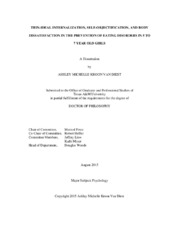| dc.description.abstract | Eating disorder symptoms and risk factors, such as body dissatisfaction, thin-ideal internalization and self-objectification are increasing in prevalence and are being seen in girls at younger ages. However, little is known about the onset and development of these symptoms in girls under the age of 10. Identifying the age of onset and factors that foster the development of these symptoms is pertinent to developing age appropriate eating disorder prevention programs. The aim of the current study is to explore the age of onset and factors that influence the development of thin-ideal internalization, self-objectification, body dissatisfaction, and eating disorder symptoms in 5 to 7 year old girls. Since previous research has identified mothers’ as influential in the development of body dissatisfaction and eating disorder symptoms in adolescent girls, the current study will explore the mother-daughter relationship in a younger sample with regards to eating disorder symptoms.
Participants for the current study included 151 mother-daughter pairs. Each pair completed individual mirror exposure exercises and a joint mirror exposure exercise with both mother and daughter participating. Mothers then completed a survey on their own self-objectification, thin-ideal internalization, body dissatisfaction, and eating disorder symptoms. Daughters completed a semi-structured interview to assess these same constructs. Demographic information was provided by mothers, and body mass indexes were directly measured for both mothers and daughters.
Results from the current study indicate that girls as young as 5 years old are beginning to report experiencing self-objectification, thin-ideal internalization, body dissatisfaction, and eating disorder symptoms, with most of these variables steadily increasing as age increases. Additionally, mothers’ comments about her own body dissatisfaction in the presence of her daughter can directly impact their daughters’ comments about their own bodies, with mothers who make more negative comments about their bodies having daughters who also make more negative comments about their own bodies. These results can be used to aid the development of prevention programs designed to educate mothers on the impact they have on their daughters, as well as ways that they can shape their daughters’ body image to be more positive in an effort to prevent eating disorder symptoms. | en |


